Description
- Clean and Unlimited Solar Energy: 100% clean and unlimited solar energy with smart MPPT controller for your camping or family emergency storage. The power station can be fully charged with 2 Jackery SolarSaga 200W solar panels within 7.5 hrs or only 2 hrs via AC wall outlet charging. (*Fully charged with 6 SolarSaga 200W solar panels (other 4 Solar Panels should be bought separately) in less than 2.5 hrs.)
- Easy to Use: The ergonomic shape of the handle grants an ease grip. And use in one touch with simple and speedy setup within 60s to enjoy outstanding charging efficiency. The Explorer 2000 PRO delivers under 53DB ensuring quiet and peaceful charging.
- Safe & Reliable for Outdoor Camping: Features industry-leading cylindrical batteries (popular with manufacturers of Electric Vehicles) that meet UL safety standards. Certified with Impact-Resistance Class 9, passing the UL drop test (withstanding 3 drops from 0.9m height on any surface). The pure sine wave inverter delivers constant voltage that protects equipment from damage.
- Power Pretty Much Anything: Power 99% home appliances with 2160Wh (2200W AC output power) and 8 outlets (3*AC outlets, 2*USB-A quick charge 3.0, 2*USB-C PD 100W, 1*Car outlet). Ideal for outdoor off-grid activities and home backup power to power the most of your appliances – pellet smokers, mini coolers, ebikes, refrigerators, air conditioners and more.
- 5-Year Warranty: Jackery Solar Generator 2000 PRO can be extended to 5-year guarantee instead of 2 years for worry-free experience.
- What You Get: 1*Jackery Explorer 2000 PRO Portable Power Station, 2*SolarSaga 200W Solar Panels, 1*DC7909 to DC8020 Adapter, 1* Car Charge Cable, 1*AC Charge Cable, 9.8 feet DC charging cable, 1* carrying bag for SolarSaga 200W, 1* User Manual.
- Kindly note that the power station and the solar panel(s) will be shipped in separate packages.
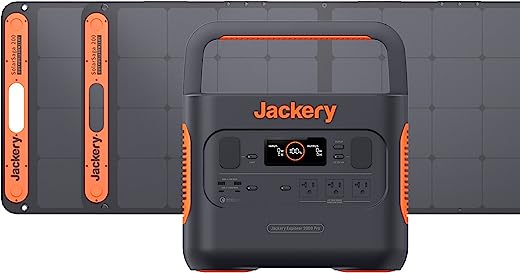
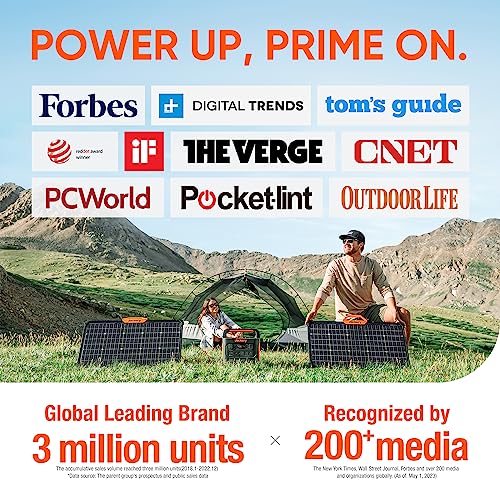
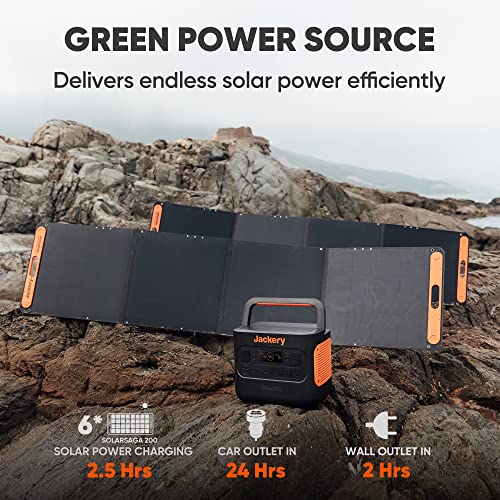
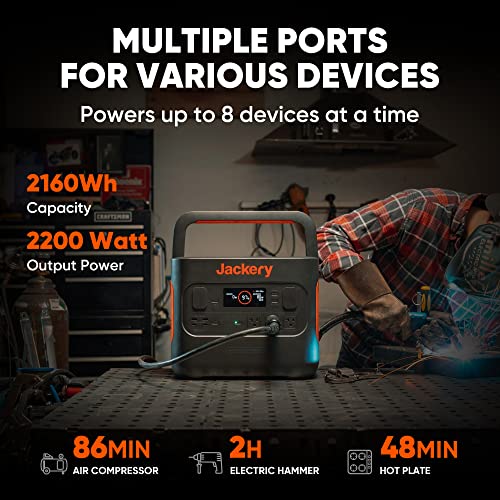
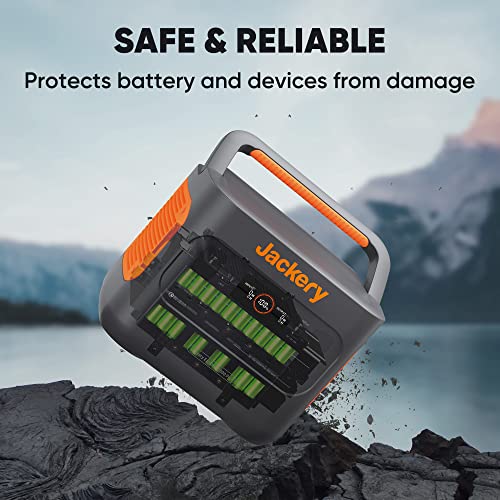


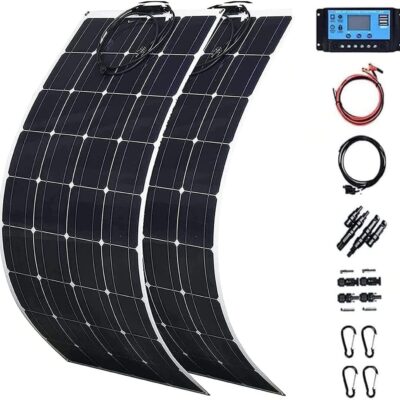
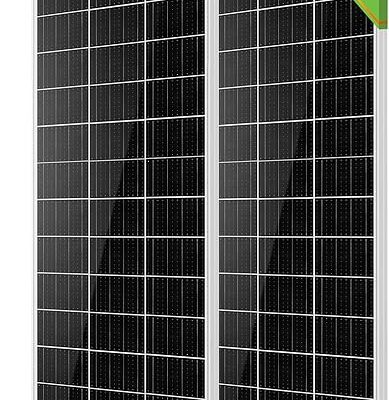
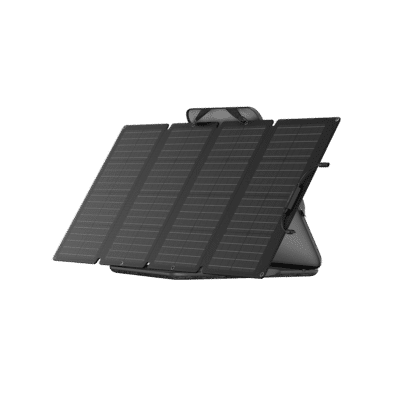
Kathryn –
We like everything about this product. We have used it multiple times now during power outages and it’s works great. No hassle with gas and maintenance. It’s very portable and is so silent.
Amazon Customer –
The Jackery 2000 Pro is a quality product. A bit heavy, but expected for the outstanding capacity. Kudos to Team Jackery for their exceptional response and service.
Outdoor Enthusiast | Geek | Photographer –
I am intending to use this for a camper that I am building. It is powerful enough to run things like a microwave with enough battery that it can hold up to that kind of use.
It is large and heavy, but the handle seems sturdy enough to carry it around. I can lift it it up onto a shelf to plug it in, but not everyone will be able to. It is over 40lbs.
My load testing on the unit indicates either 2160Whr is extremely optimistic, or the inverter that they used is really inefficient. I did some load testing with a 1kW space heater and a small fan. The space heater drained about 80% in 1hr 37min.
The low load testing was a bit disappointing. Low load is where you find out how efficient the inverter and stuff are. I ran a 14W load (a small fan) on it for 10 hours 45 minutes, and it dropped it 20%. 20% of the battery is 460Whr, but the fan only drew 150WHr, the remaining 300Whr consumed is just from the inverter being inefficient. It is worth noting that all inverters do this, but this one seems to be below average for efficiency.
I timed the charging from 20% to 100% at 1 hr 21 minutes, which is definitely fast. There is a fan on the unit that runs while it is charging, but is pretty quiet; I didn’t notice it. The active cooling requirement would suggest it isn’t a good idea to leave this thing in the bottom of a cabinet though, which is a bit unfortunate for my use case, but not a terribly big deal.
I compared its power output to a kill-a-watt type device, and it was accurate.
Given that my use case is to run a camper for a day or two at the most, I think it would suffice just due to sheer battery capacity. It’s fast charge times mean that if I have to bring it out to charge, it will charge before I need to worry about the fridge warming up. It costs a pretty penny, but is large enough to run a house for a short while as well.
Stargazer –
This is an awesome generator. Small and easy to move around. Exactly what I had been looking for. Will be great for emergency use at home or for powering just about anything while out camping. The 6 provided panels are lightweight and easy to maneuver. No complaints regarding my purchase of this 2000 pro model.
Outdoor Enthusiast | Geek | Photographer –
SUMMARY
– PROS: Large battery capacity / High AC inverter output / Fast charging / Modern look with beautiful display / Customer service, 5-year warranty
– CONS: Heavy / Plastic enclosure / No Anderson Power Pole (APP) port / 8mm port changed to DC8020 / No mobile app support
INTRO
Upgraded power stations and solar panels had been announced by Jackery during their annual “Jackery Day” since I purchased their Explorer 1000 (E1000) in 2020. What made the E1000 a good pick was its feature set, lower price, lighter weight, excellent customer service, and better value than the Goal Zero Yeti 1000x, although at a lower build quality and with slightly diminished technical engineering. Lately, I had been noticing an influx of impressive products coming out of manufacturers old and new, including EcoFlow’s Delta Pro that wowed me to no end. Some had even started to diversify their portfolio, like EcoFlow releasing its first, portable air conditioner — the Wave — in their quest to gain market share.
It came as no surprise that Jackery had to come up with something new in the face of their Explorer 1000 showing its age. The company in September 2022 announced its new flagship product at Berlin’s IFA consumer electronics trade show, the Explorer 1000 Pro, and in May 2022 in New York, the Explorer 2000 Pro. Some of their touted features was fast-charging that promised to take an empty battery to full within just a couple hours. We love that trend!
We will be comparing the Explorer 2000 Pro against our Goal Zero Yeti 1500x and, to a small extent, the EcoFlow Delta Pro.
ANALYSIS
The Jackery Explorer 2000 Pro, like Goal Zero, continued with the company’s tradition to use the Lithium-ion NMC (Nickel Manganese Cobalt) battery chemistry over the Lithium-ion LiFePO4 (Lithium Iron Phosphate) that some would swear by. Both have their pros and cons that we will go over later in this review. Competitors Bluetti and EcoFlow had been focusing on LiFePO4 as of late.
Lithium-ion NMC batteries are lighter and smaller, but more volatile and pricier, less usable in extreme temperatures, and have a lower charge cycle count (battery lifetime) than LiFePO4.
Immediately noticeable was the new, more refined, modern look over its Explorer 1000 predecessor, and — FINALLY — a carry handle that could be folded away for easier packing and less wasted storage space. Jackery at last copied the design of the Goal Zero Yeti 500x! The company also upgraded the display to a stunning color one that was readable (but glaring) under direct sunlight and provided a bit more information than before: how much time was remaining before empty or fully charged. Another previous complaint addressed. Nice!
The supplied covers protected the three-brightness-level LED light and car port against dust, but were sometimes finicky or difficult to put back on. One should note that, like EcoFlow, the E2000 Pro no longer supplied a bulky AC power brick to charge with. Instead, you now only needed to plug a cable directly into the unit — simple and clean. Nice move! Goal Zero, are you watching?
With a 2,160Wh battery capacity made by BAK Battery, you could, for example, power a 60W laptop continuously for up to 36 hours, a CPAP machine for 32-72 hours, and a car freezer for 4 or more days, depending on ambient temperature. An equally important pair of numbers to look at is the 2,200W continuous and 4,400W peak output rating with a pure sine wave AC inverter. The two-year-old Yeti 1500x only has 2,000W and 3,500W, respectively. If those numbers do not make sense to you, do not worry. We will go over Continuous vs Peak (Surge) in more detail later. Essentially, 2,200W allows you to run virtually anything, including a miter saw, coffee machine, projector, pressure cooker, microwave, portable air conditioner, or even a Starlink satellite dish. The battery would automatically shut off after 12 hours of idling or very low-level use.
How much power is used or produced is measured in Watts, and how much energy a battery can store is calculated in Watt-Hours.
What made the new Explorer a Pro versus its non-Pro models? Simply put: the speed at which the power station could be charged. The 2000 Pro could now be charged from empty to full in as little as 2 hours from the AC wall (120V @ 15A at 1,800W), or as fast as 2.5 hours with an array of solar panels (60V @ 24A at 1,400W max) and optional Jackery parallel cable. It slowed down rapid-charging once nearing 80% for safety reasons. The fast charging significantly outperformed the aging Goal Zero Yeti X series, but was on par with the 1,800W AC (120V) or 1,600W solar input of the EcoFlow Delta Pro. One should note that at 240V, the Delta Pro could charge at a whopping 3,000W AC input.
Another important difference between the Pro vs non-Pro: change in the 8mm connector. Where the older Jackery Explorers and SolarSaga solar panels used the standard DC7909 plug (7.9mm outer, 0.9mm inner diameters), the 2021 and newer models now use the slightly larger DC8020 (8.0mm outer, 2.0mm inner). The center pin was now thicker. Why the change? To accommodate for the increased fast-charging current. That also meant that an adapter (free from Jackery, if one was not included, or buy SolarEnz) was needed for the older products to be used with the newer ones (or even some Goal Zero items). Yes, both companies’ DC7909 connectors were similar enough for many of their goods to be used interchangeably although the barrel design was not an exact match. Jackery moved the DC8020 input — which their new solar panels use — to the rear alongside the AC port.
The front-left of the Jackery found two USB-A and two USB-C PD outputs at 18W (Quick Charge 3.0) and 100W, respectively. USB-C PD is “Power Delivery” to charge laptops, for example, that support it. Three AC and a 120W car port flanked the front-right of the US version. Two, bright orange cables were included: rear AC input and car port output.
Jackery Explorer 1000, 500, 300, and SolarSaga 60W, 100W use the 7.9mm (DC7909) plug. Since 2021, the Explorer 1500, 1000 Pro, 2000 Pro, and SolarSaga 200W use the new 8mm (DC8020) barrel.
Jackery got rid of the Anderson Power Pole (APP) port. Boo! You now needed to buy a DC8020-to-MC4 or DC8020-to-APP adapter cable to connect solar panels with. I was not happy with that move.
Under the hood, the 43 lbs @ 15.1″ L x 10.5″ W x 12.1″ D made the 2000 Pro relatively heavier and larger than its previous generation when extrapolated to the same capacity, but alas, the company had not yet switched to LiFePO4. It was still slightly lighter and taller than the lower-capacity, but better-built Goal Zero Yeti 1500x (45.6 lbs @ 15.3″ x 10.2″ x 10.4″).
Could the E2000 Pro be used while charging? Absolutely. Pass-through power was available, but with the following output limitations to charge devices with while the Jackery was plugged in:
– While on AC input: 1,800W max output
– While on AC and DC input: 1,800W max output
– While on DC input: 2,200W max output. Solar provides DC input
One big advantage that Jackery, EcoFlow, BigBlue, and several other brands had over Goal Zero was the discharge rate when not in use. Both the Explorer 1000 and 300 retained their battery capacity for over a year (with 10-20% loss) while sitting idle, whereas the Yeti 1500x, 1000x, 1000 Core, and 500x all lost 50-90% over the same period. Goal Zero never provided an explanation of why their products drained faster than their competitors, but all companies did advise in their manual to check every 3-6 months to ensure their batteries were between 50-80% when stored long term. Do not let the battery drop to below 20% for prolonged periods, and absolutely never let lithium-ion sit at 0% for a long time or it may no longer be revivable without a specialized tool, if at all.
CAUTION: Lithium-ion (LiFePO4 and NMC) batteries do NOT like to remain discharged at 0% for prolonged periods of time. If you let your battery stay at 0% for too long, you may not be able to charge it again without specialized equipment.
Jackery, unfortunately, was still behind Goal Zero and EcoFlow when it came to mobile app support. The Explorer 1000 Pro and 2000 Pro did not have WiFi, Bluetooth, or app support, and that was a shame as neither remote control nor firmware updates were available to provide fixes or feature enhancements.
We were happy to see Jackery keeping its built-in light (with 3 intensity levels) that could stay on or signal “S-O-S”, but this time, it actually blinked the distress signal correctly in morse code. If only minor issues like this could be corrected on older Explorer models via firmware updates… Warranty for the Pro series came with 3 years standard and could be extended to 5 years with registration.
Jackery got rid of the Anderson Power Pole (APP) port and replaced it with its proprietary DC8020 connector. Boo! That meant that solar panels now required a DC7909-to-DC8020 (like SolarEnz) and an 8mm-to-MC4 or 8mm-to-APP adapter. I was not happy with that decision as the APP interface was a much better and more secure design.
What was the difference between the Jackery Explorer 2000 Pro and their Solar Generator 2000 Pro? Technically, “Solar Generator” was a bit misleading as the power stations themselves did not “generate” electricity. Instead, all they did was store energy in their battery cells. The company used the “Solar Generator” term to signify a discounted bundle consisting of an Explorer power station and one or more SolarSaga solar panels. The latter would be used to generate electricity.
The carry bag for the Explorer 2000 Pro was a much-needed improvement over the one provided for the Explorer 1000. It felt and looked more professional and now included a mesh pocket underneath the lid to store cables and accessories with. We always buy a bag to protect our expensive investment against dust and accidental spills.
Overall, the new Jackery Explorer 2000 Pro had made many improvements over its predecessors, including rapid charging, a fresh and streamlined look, colorful and more informative display, stowable carry handle, drop resistance, longer warranty period, and higher AC inverter output, but still stayed limited to being a standalone product without the vast ecosystem of goods and accessories available with Goal Zero or EcoFlow. Nonetheless, Jackery continued to be known for their excellent customer service and had remained a good choice to buy power solutions from.
USAGE
– Turn off any output ports (AC/DC) that are not being used in order to conserve power
— Without anything plugged in, the AC inverter still draws 7W on its own
– To prolong the battery lifetime while in storage, keep the battery fully charged every 3-6 months
— Or, according to some companies, including Goal Zero, keep it plugged in when not in use and discharge it to 50% every 3-4 months
— The charging controller automatically gets disabled once the battery is full
— You may also charge it to 80% for storage, but be sure to discharge to 20% every 3-4 months
— NOT using the battery for a very long time can actually hurt its lifetime
— There is no “memory effect” in this station’s battery
—- Note: It is better to NOT let it completely drain before recharging
— Battery, like all LiFePO4 and NMC, slowly drains over time even when station is powered off
—- Could take 1-1.5 years to go from full to empty
CAUTION: Lithium-ion (LiFePO4 and NMC) batteries do NOT like to remain discharged at 0% for prolonged periods of time. If you let your battery stay at 0% for too long, you may not be able to charge it again without specialized equipment.
CONTINUOUS VS PEAK OUTPUT
It is important to understand the difference between Watts and Watt-Hours. How much power is used or produced is measured in Watts, and how much energy a battery can store is calculated in Watt-Hours. See the “Calculations” section below for more details.
How much energy a battery can store is measured in Wh (Watt-hours), and how much power is used or produced in W (Watts).
– AC Inverter: Converts battery (DC) power into AC
— Explorer 2000 Pro provides 2,200W continuous output with a 4,400W peak
– Peak/Surge (Starting): Nearly every device initially draws extra power to turn on. The highest amount it pulls is the Peak. As long as that number is below 4,400W, it can be STARTED
— Turns on OK (PEAK under 4,400W):
— Freezer starts at 400W (peak), runs at 150W once on
— Coffee maker starts at 1,400W (peak), runs at 800W once on
— Will NOT turn on (PEAK over 4,400W):
— A heavy-duty tool starts at 4,900W (peak), runs at 1,900W once on
Most devices power on at a higher (Peak) wattage than when they are already on (Continuous). Therefore, if its peak exceeds the power station’s max, it may not be able to start
– Continuous Output (Running): Once devices are on, as long as they keep drawing less than 2,200W total, they will stay ON until the battery runs out
— CONTINUES running (under 2,200W)
— 100W TV + 60W laptop = 160W
— COULD STOP running (over 2,200W)
— Temporary overdrawing beyond 2,200W for a few seconds is okay. A quality BMS will protectively shut down the battery if the surge does not end after a while. Regularly going over for a prolonged time can ruin the battery in the long run
— 100W TV (120W peak) + 1,000W Home AC (4,000W peak) + 800W Coffee maker (1,400W peak) + 400W appliance = 2,300 W. Probably will stay on for a short period
—- Add 1,000W mower (1,400W peak) = 3,300W. Battery will definitely shut down
SOLAR PANEL – WARNING
This power station can be charged with one or more solar panels as described in the “Ports > Input” section. There are SOME PRECAUTIONS you must take to minimize battery damage and/or injury to life/property:
– Never exceed the maximum Voltage (V) or Amperage (A) of the power station’s charging port
– If you want to use 2+ solar panels to charge faster:
— Do not mix them with different V or A as the output might get reduced (less energy generated)
— Do not daisy-chain them in sequence/series as that can exceed the power station’s maximum V or A
— Always connect them in PARALLEL with a Y-branch or Combiner cable
– Keep the battery out of direct sunlight while charging. You may have to use an extension cable to keep it in the shade
Wondering what size solar panel to get? See the “Calculations” section below.
CALCULATIONS: SIZE & TIME
What size battery should you get? How long will it power your fridge for? How long will it take to recharge? The below calculations can help answer those questions and are rough ESTIMATES as conditions, battery quality, and age can vary.
TIME TO CHARGE BATTERY
Calc: Hours to charge battery = Battery capacity (Wh) / Input Wattage
– Note: As battery approaches 75% full, the input charge will increasingly be slowed down to prevent overcharging
– AC Wall: 1,800W @ 1.2 hrs [2,160 Wh / 1,800W]
CHARGE TIME WITH SOLAR
Calc: Hours to charge battery = Battery capacity (Wh) / (Panel Wattage x [0.5 or 0.75])
– In a perfect lab environment, solar panels charge at the listed wattage
– Expect to only receive 50-75% on a good, sunny day (ie. 75W – 113W for a 150W panel), depending on panel’s age, component quality, and weather
– Two 400W solar panels: as fast as 3.6 hours [2,160Wh / (2 x 400W x 0.75)]
– Tips
— Keep charging even when overcast as the panels will STILL collect energy
— Underproduction: If a 200W panel is not making enough (ie. only 50W) due to bad conditions, adding extra ones (ie. two more 200W) can generate a higher, combined output (ie. 50W + 110W from the two panels = 160W total)
— Overproduction: If the panels make more (ie. 400W) than the maximum the power station charge port can take (ie. 120W), only the max (ie. 120W) will go through
WATTS USED/PRODUCED
Calc: Watts used or produced by device = Voltage x Amperage
– Vacuum with 120V @ 9.5A uses 1,140W
– Solar panel with 12V @ 10A can produce up to 120W
IDEAL BATTERY SIZE
Calc: Battery capacity (Wh) = Watts used by device x Hours needed for / 0.85
– 10-15% of power is lost during power conversion
– 45W car fridge needed for 8 hours: Minimum 424Wh power station (45W x 8 / 0.85)
How much energy a battery can store is measured in Wh (Watt-hours), and how much power is used or produced in W (Watts).
TIME BEFORE BATTERY IS EMPTY
Calc: Hours available for device = Battery capacity (Wh) x 0.85 / Watts used by device
– 10-15% of power is lost during power conversion
– 60W laptop with 505Wh battery: Up to 7.2 hours (505Wh x 0.85 / 60W)
TIME TO CHARGE DEVICE
Calc: Hours to charge device = Device’s battery capacity (Wh) / Input Wattage
– 60W laptop with 200Wh battery: Up to 3.4 hrs (200 Wh / 60W)
CONVERION TO MAH
Calc: Powerbank-equivalent capacity (mAh) = Battery capacity (Wh) / Voltage x 1000
– 1 Ah = 1000 mAh
– Jackery Explorer 2000 Pro @ 3.7V = 583,783 mAh power bank (2,160 Wh / 3.7V x 1000) or 200,000 mAh @ 10.8V
JUMP START CAR?
A battery power station like this one cannot be used to jump start a car. Instead, I suggest getting a small, portable one specifically made for that, such as my favorite: NOCO Genius Boost Car Jump Starter (Lithium Battery).
GOAL ZERO 12V CAR CHARGER
I wanted to point out how GAME-CHANGING the Goal Zero 12V Car Charger is (Buy on Goal Zero/Amazon). The company inexplicably does not promote its benefits enough, but it can be used to charge batteries at a whopping 120W when the car port supports 10A (like my Toyota Highlander 2008 did!) All other car chargers I have (Jackery, Rockpals, Paxcess) only go up to 60W, but the Goal Zero can double that! What does that mean? Faster charging while driving around town! I bought two — one for use with the Yeti 1500x and another with the Jackery Explorer 1000.
The Goal Zero 12V Car Charger can charge a Goal Zero/Jackery battery at a whopping 120W!
CONCLUSION
Jackery launched a new Pro series of its Explorer brand with faster charging, a new 8mm connector, longer warranty (5 years with registration), and a sleek, more modern design. They got rid of the standard Anderson Power Pole (APP) port (boo!) and still have not yet provided a mobile app for remote control or firmware updates. Its large AC inverter output was capable of virtually any appliance or device I could throw at it, and it was handled like a champ without the noise and pollution of a gas generator.
The company’s excellent customer service and roughly $1/Wh pricing continued to help Jackery be a value-added brand to be reckoned with and had remained a solid recommendation for portable power. At some point, I do hope that Jackery would expand into the home and/or vehicle integration market that Goal Zero and EcoFlow have already established a market share for.
LI-ION: LIFEPO4 VS NMC
There has been a lot of debate on whether Nickel Manganese Cobalt (NMC) or Lithium Iron Phosphate (LiFePO4) is better. Both are Lithium-ion batteries. Goal Zero, Jackery, and most of today’s power station manufacturers use NMC, but why do EcoFlow and Bluetti use LiFePO4 when they are bulkier and heavier? They hold some important advantages over NMC:
– Safer, less volatile, and thus cheaper to manufacture
– Charge cycle: 1500-2000 (10+ years)
— NMC: 20-25% capacity loss after every 500 cycle (6-10 years with up to 2000 cycles, but diminishing capacity over time)
– Usable in more extreme temperatures (-4F/-20C to 176F/80C). NMC: only 140F/60C max
— Check with manufacturer for your battery to be sure
– Holds 350-day charge. NMC: 300
LiFePO4 batteries are less volatile (safer), more usable in extreme temperatures, and have a higher charge cycle count (battery lifetime) than NMC
Allen V. –
Great product so far. It took about less than 2hrs to charge the generator using the AC cord. I haven’t tried the solar panels yet but will soon. I almost bought a solar connector for the panels but saw some reviews about checking the inside pocket for it. I thought Jackery had forgotten to include one but it’s in there! – the jacket that the solar panels come in is so lightweight that I failed to check the inside pocket. So quick question, do I need two of them to charge up the solar panels?? I wish the generator came on wheels which helps with transporting it as it is pretty heavy to lift.
Allen V. –
We live in an area where the power goes out five or six times a winter. Usually for less than 12 hours, but maybe once a year for 24 to 48 hours.
This size unit is perfect for that.
It will power our refrigerator, phones and tablet for 24 hours.
Extremely simple to use, I glanced at the instructions briefly, but it’s pretty intuitive how to use it.
And on those rare occasions when the power is out for more than 24 hours, I can connect it to the two Jackery 200 watt solar panels that I purchased to recharge it.
Much easier to use, much quieter, and much more environmentally friendly than a gas backup generator. And you never have to worry about failure to start, or mechanical breakdowns, like you do with a gas generator. It will never let you down (unless you have operator error and fail to recharge it when the battery gets close to zero).
Frequent Amazon Shopper –
Purpose for buying: maintain power to key home appliances during temporary power failures.
Test 1: plugged a mid-size fridge in my E2000 Pro and ~50% power left after 24 hour continuous use (presumably you’d get ~48 hours on a full charge). Very good results.
Test 2: simultaneously had 2 mid-size (one fridge and one freezer) plugged in ~30% power left after 12 hours straight. Very good results
Test 3: plugged in 2 space heaters (900w each) and ~ 1 hour and power was down to 0%. Not ideal use for heating with portable units for a long period.
Very happy with my tests so far. For the price, Jackery should considerer offering the carrying/storage bag. Had to order and pay separately.
Bethany D. –
Overall I am very pleased with my Jackery 2000 pro. I have tested it with all sorts of loads simulating a power outage situation and it performed really well. I love the fast charge feature. I was also impressed with the solar charging with 6 Solar Saga 100’s. I have seen You Tube videos of the 200’s, but I’m glad I got the 100’s instead as shown in many videos. I don’t have a giant backyard for those larger panels. The weight is about the max for me. I know there are better batteries out there, but the extra weight is a deal breaker for me. My scope weighs about the same and I prefer under 50 lbs. I will be mostly using this for camping and to power my telescope equipment among other devices. It’s over kill for that, but it will also serve as a emergency power source for my house when the power goes out. I reason I’m giving 4 stars is for the higher price and instead of a light, I would have preferred another power outlet. These are minor gripes. I would recommend this to anyone who is going to use it for the same purposes as me.
Bethany D. –
Have not tried to use it yet, but plan to try it out soon. Living in Florida with half the year in Hurricane Season, I am hopeful this will serve my needs if the power ever goes out. I do not like the noise, fumes, and inconvenience of gas generators (filling gas cans, transporting the cans in an open SUV, and storing them in a hot garage), so this was a terrific alternative.